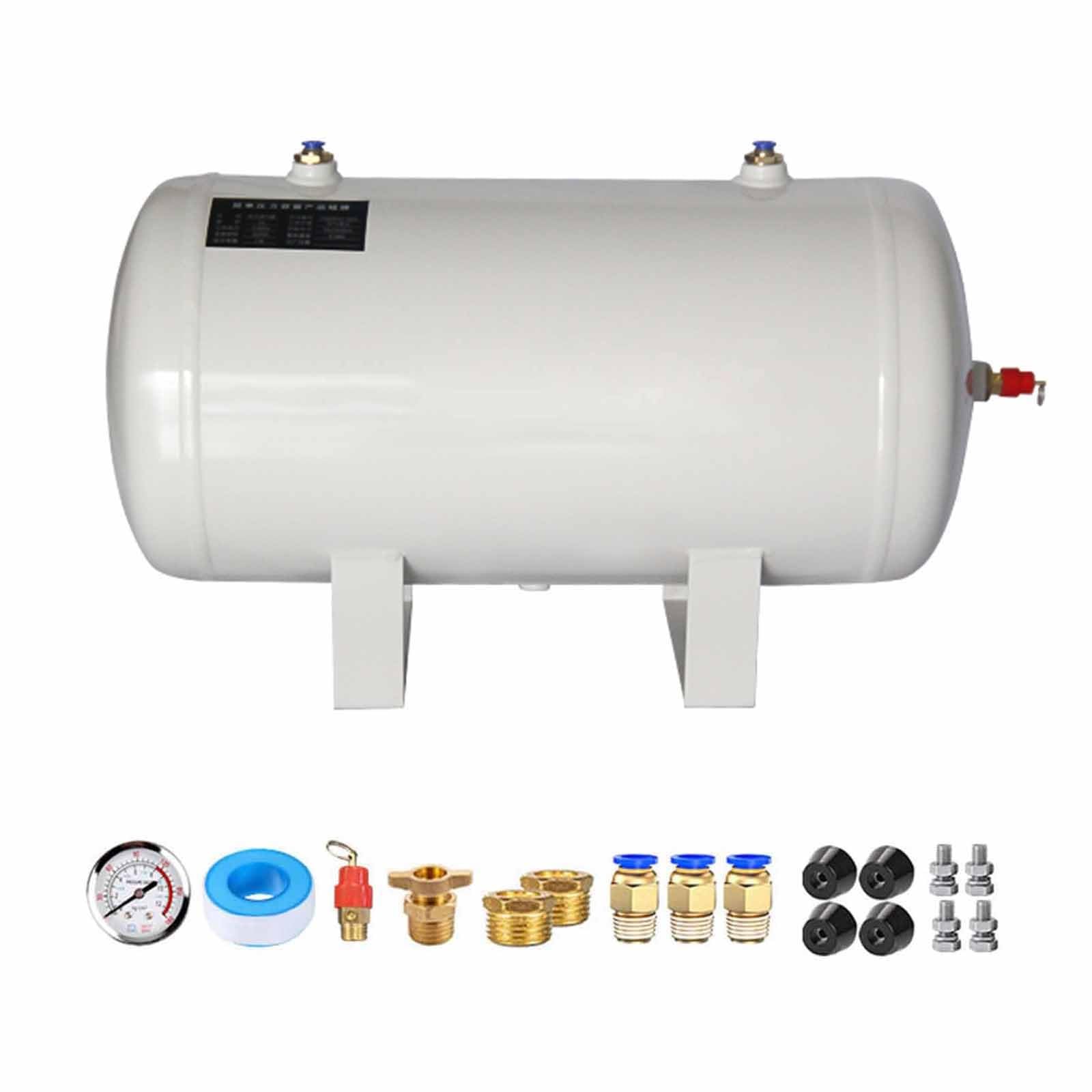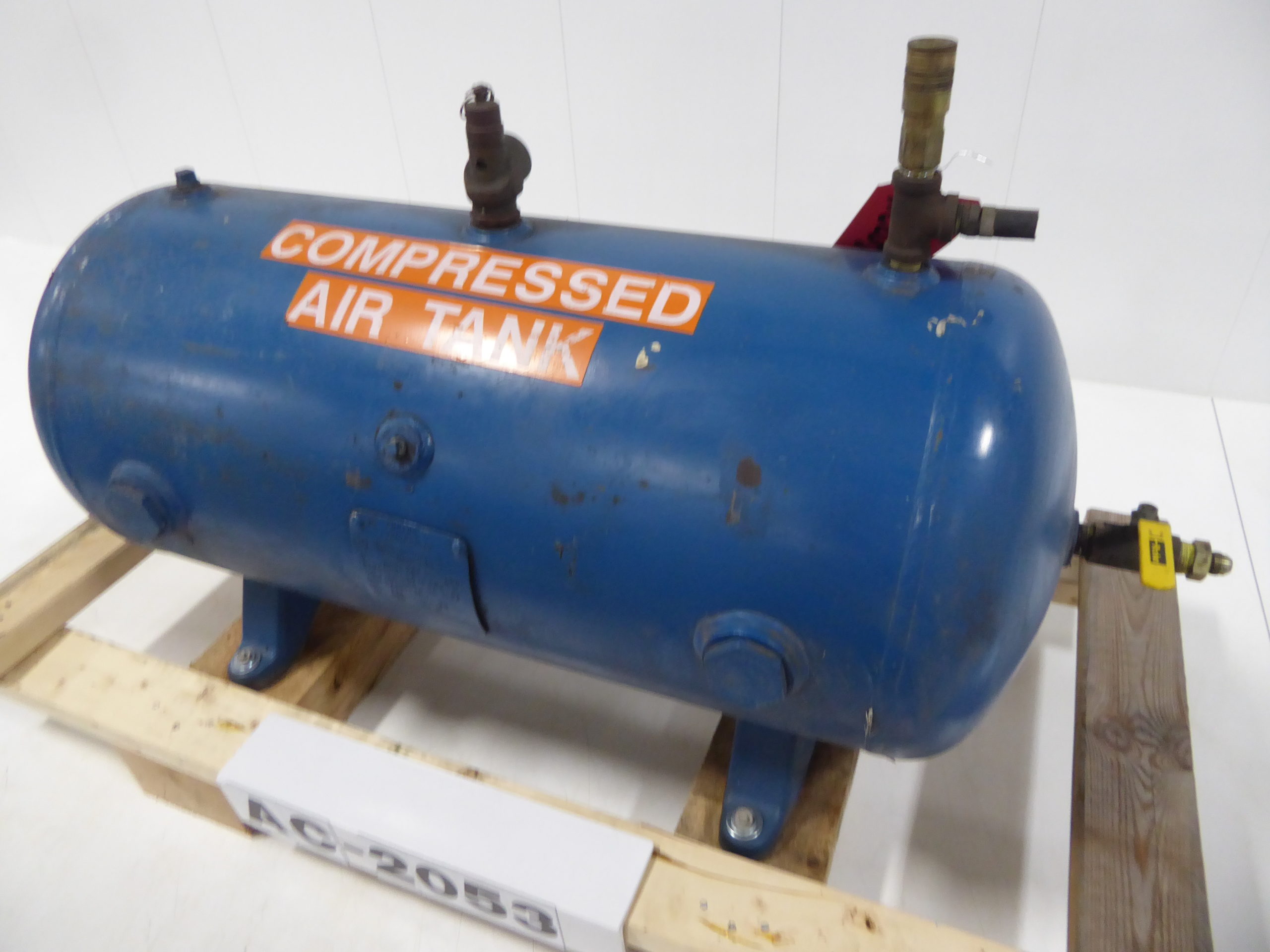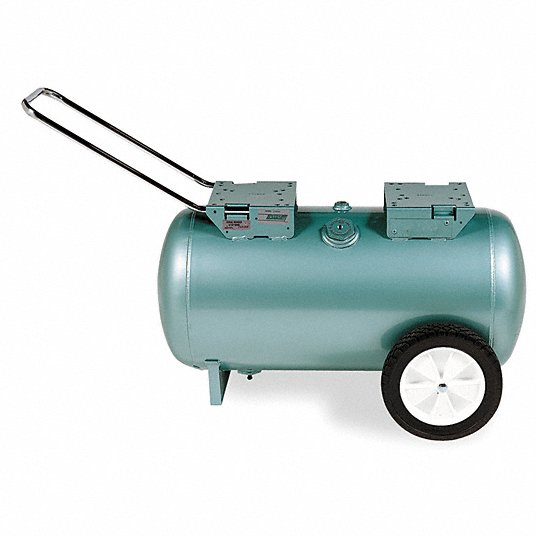Air compressor tanks store compressed air for various applications. They ensure a steady supply of air for tools and equipment.
Air compressor tanks play a crucial role in many industries, from construction to automotive repair. These tanks act as reservoirs, holding compressed air until it’s needed. By maintaining pressure, they allow for consistent operation of pneumatic tools. The size and type of the tank can significantly influence performance and efficiency.
Users must consider factors like tank capacity and pressure ratings to match their specific needs. Regular maintenance ensures optimal function and longevity of the tank. Understanding how these tanks work can enhance productivity and reduce downtime, making them essential for both professionals and DIY enthusiasts alike.

Credit: www.amazon.com
Introduction To Air Compressor Tanks
Air compressor tanks play a vital role in many industries. They store compressed air for various applications. Understanding their function helps users optimize their performance.
Essential Role In Various Industries
Air compressor tanks are crucial in multiple fields. Here are some key industries that rely on them:
- Manufacturing – Powers tools and machines.
- Construction – Supplies air for pneumatic tools.
- Aerospace – Supports testing and assembly processes.
- Automotive – Assists in painting and tire inflation.
- Healthcare – Provides air for medical equipment.
Key Components And Functions
Understanding the components of air compressor tanks is essential. Here are the main parts:
| Component | Function |
|---|---|
| Tank | Stores compressed air safely. |
| Pressure Switch | Controls tank pressure levels. |
| Safety Valve | Prevents over-pressurization. |
| Drain Valve | Removes moisture from the tank. |
| Air Outlet | Distributes compressed air to tools. |
Each component plays a critical role in the tank’s performance. Proper maintenance ensures longevity and efficiency.
Types Of Air Compressor Tanks
Understanding the types of air compressor tanks helps in choosing the right one. Each type has unique features and benefits. This section covers two main categories: orientation and material.
Vertical Vs. Horizontal Orientation
Air compressor tanks come in two orientations: vertical and horizontal. Each has its advantages and applications.
- Vertical Tanks
- Space-saving design.
- Higher capacity in smaller footprints.
- Ideal for workshops with limited floor space.
- Horizontal Tanks
- Stable base for heavy-duty applications.
- Easy to transport and install.
- Offers more air volume for large tasks.
Material Considerations: Steel Vs. Aluminum
The choice of material impacts durability and performance. Steel and aluminum are the most common materials used.
| Material | Advantages | Disadvantages |
|---|---|---|
| Steel |
|
|
| Aluminum |
|
|
Maximizing Efficiency Of Compressor Tanks
Efficient compressor tanks boost performance and save energy costs. Proper management ensures optimal operation. Understanding tank sizing and pressure settings is essential.
Optimal Tank Sizing
Selecting the right tank size is crucial for efficiency. A tank that is too small leads to frequent cycling. This wastes energy and reduces lifespan. A larger tank can store more air, reducing the need for the compressor to run constantly.
- Consider the following factors for sizing:
- Air demand of your tools.
- Compressor output capacity.
- Duty cycle requirements.
| Application | Recommended Tank Size (Gallons) |
|---|---|
| Home DIY | 6-10 |
| Small Workshop | 20-30 |
| Industrial Use | 50+ |
Pressure Settings And Energy Consumption
Pressure settings directly impact energy use. Higher pressure requires more energy. Setting the correct pressure saves energy and increases efficiency.
- Maintain the ideal pressure:
- Check manufacturer guidelines.
- Monitor pressure regularly.
Consider using a pressure regulator. This keeps pressure stable. A stable pressure reduces energy spikes.
- Benefits of optimal pressure settings:
- Lower energy bills.
- Extended equipment lifespan.
- Consistent airflow for tools.
Maintenance Strategies For Longevity
Proper maintenance of air compressor tanks ensures they last longer. Simple strategies can prevent costly repairs. Regular checks keep your equipment safe and efficient.
Routine Inspection Checklist
- Visual Inspection: Check for rust or corrosion.
- Leak Detection: Listen for hissing sounds around connections.
- Pressure Gauge: Ensure it shows normal readings.
- Drain Valve: Open it to remove moisture and dirt.
- Mounting Bolts: Ensure they are tight and secure.
Common Maintenance Procedures
- Regular Cleaning: Clean the exterior with a damp cloth.
- Lubrication: Apply oil to moving parts as needed.
- Filter Replacement: Change air filters every six months.
- Drain Tank: Empty the tank weekly to prevent rust.
- Check Belts: Inspect for wear and adjust tension.
| Maintenance Task | Frequency | Importance |
|---|---|---|
| Visual Inspection | Monthly | High |
| Drain Tank | Weekly | Critical |
| Change Filters | Every 6 Months | Medium |
| Lubrication | As Needed | Medium |
Preventing Corrosion And Wear
Air compressor tanks face corrosion and wear from various factors. Protecting these tanks is crucial for their longevity. Proper maintenance can save costs and enhance safety. The following methods help in preventing damage.
Protective Coatings
Applying protective coatings can significantly reduce corrosion. Various types of coatings are available:
- Epoxy Coatings: Durable and resistant to chemicals.
- PVC Coatings: Affordable and provides good insulation.
- Powder Coatings: Offers a tough finish that resists scratches.
Choose a coating suitable for your environment. Regularly inspect the coating for damage. Reapply as needed to maintain protection.
Environmental Factors And Storage
Environmental conditions impact the lifespan of air compressor tanks. Key factors include:
| Factor | Impact |
|---|---|
| Humidity | Increases rust and corrosion risk. |
| Temperature | Extreme heat or cold can weaken materials. |
| Contaminants | Dust and debris can accelerate wear. |
Store tanks in a dry, controlled environment. Avoid exposure to harsh elements. Regular cleaning helps minimize contaminants.

Credit: lanco-corp.com
Safety Measures And Compliance
Air compressors can be powerful tools. Ensuring safety is crucial. Proper safety measures protect users and equipment. Compliance with regulations is essential for safe operation.
Pressure Relief Valves
Pressure relief valves are vital for safety. They prevent excessive pressure buildup. Here are key points about pressure relief valves:
- Function: They release air when pressure exceeds safe levels.
- Location: Installed on the compressor tank.
- Maintenance: Regular checks ensure they work correctly.
Follow these steps for valve maintenance:
- Inspect valves monthly.
- Clean any dirt or debris.
- Test the valve operation regularly.
Always replace faulty valves immediately. This prevents dangerous situations.
Adhering To Industry Standards
Complying with industry standards is essential. Standards ensure safety and efficiency. Here are important standards to consider:
| Standard | Description |
|---|---|
| OSHA | Occupational Safety and Health Administration regulations. |
| ASME | American Society of Mechanical Engineers guidelines. |
| ISO | International Organization for Standardization requirements. |
Follow these steps to ensure compliance:
- Review safety regulations regularly.
- Train staff on safety protocols.
- Document all safety checks and repairs.
Staying compliant protects everyone involved. It also enhances the performance of air compressor tanks.
Troubleshooting Common Issues
Air compressor tanks can face various issues over time. Understanding these problems helps in effective troubleshooting. This section covers common issues, focusing on leak detection, pressure fluctuations, and their solutions.
Leak Detection And Repair
Leaks in air compressor tanks can lead to performance issues. Identifying leaks quickly is crucial. Here are steps to detect and repair leaks:
- Visual Inspection: Look for rust or wet spots.
- Soap Test: Mix soap with water. Apply it to suspect areas. Bubbles indicate a leak.
- Listen: Pay attention for hissing sounds.
Once detected, repair options include:
- Sealant: Use a high-quality sealant for small leaks.
- Welding: Employ a professional for larger cracks.
- Replacement: Consider replacing the tank if damage is severe.
Dealing With Pressure Fluctuations
Pressure fluctuations can affect the efficiency of your air compressor. Common causes include:
| Cause | Description |
|---|---|
| Faulty Regulator | May not maintain steady pressure. |
| Blockage | Air filters or hoses may be obstructed. |
| Leakages | Leaks can cause pressure drops. |
To stabilize pressure:
- Check the Regulator: Ensure it’s functioning correctly.
- Inspect Filters: Clean or replace them as needed.
- Look for Leaks: Follow leak detection steps mentioned earlier.
Regular maintenance helps avoid these issues. Keep an eye on performance to ensure smooth operation.

Credit: www.grainger.com
Innovations In Compressor Tank Technology
Recent innovations in compressor tank technology enhance performance and efficiency. New designs focus on smart features and improved materials. These advancements lead to safer and more reliable operations.
Smart Monitoring Systems
Smart monitoring systems revolutionize how we manage compressor tanks. These systems track various metrics in real-time. Users can monitor pressure, temperature, and maintenance schedules effortlessly.
- Real-time Data: Instant updates on tank performance.
- Alerts: Notifications for irregular conditions.
- Remote Access: Control settings from anywhere.
Using smart technology improves safety. Operators can respond quickly to issues. This reduces downtime and maintenance costs.
Advancements In Durability
New materials enhance the durability of compressor tanks. Manufacturers use advanced alloys and coatings. This innovation increases resistance to wear and corrosion.
| Material | Benefits |
|---|---|
| Aluminum Alloys | Lightweight and rust-resistant |
| High-Strength Steel | Improved impact resistance |
| Ceramic Coatings | Enhanced corrosion protection |
These materials lead to longer-lasting tanks. Operators save money on replacements and repairs. Better durability ensures consistent performance in demanding environments.
Choosing The Right Air Compressor Tank
Choosing the right air compressor tank is crucial for your needs. The tank’s size and quality affect performance. Understanding your requirements helps in making the best choice.
Capacity And Performance Needs
Tank capacity determines how much air it can hold. A larger tank allows for longer use without interruptions. Here are key factors to consider:
- Usage Frequency: Daily use may require a larger tank.
- Tools and Equipment: Consider the tools you will power.
- Air Consumption: Check the CFM (Cubic Feet per Minute) rating.
Here’s a simple table to help visualize capacity needs:
| Usage Type | Recommended Tank Size |
|---|---|
| Occasional Use | 6-10 gallons |
| Moderate Use | 10-20 gallons |
| Frequent Use | 20+ gallons |
Brand And Warranty Considerations
Choosing a reputable brand ensures quality and reliability. A strong warranty protects your investment. Consider these points:
- Brand Reputation: Research brands with positive reviews.
- Warranty Length: Look for warranties of at least 1 year.
- Customer Support: Check availability of support for issues.
Brands like Ingersoll Rand and DeWalt are known for quality. They offer solid warranties and customer service. Make sure to compare options before purchasing.
Frequently Asked Questions
What Are Air Compressor Tanks Used For?
Air compressor tanks store compressed air for various applications. They provide a consistent air supply for tools, inflating tires, and painting. A larger tank allows for longer usage without frequent cycling of the compressor. This enhances efficiency and performance in both professional and DIY projects.
How Do I Choose The Right Tank Size?
Choosing the right tank size depends on your needs. Consider the tools you’ll use and their air consumption rates. For intermittent use, a smaller tank may suffice. However, for continuous operation, opt for a larger tank. This ensures you have enough air without constant compressor activation.
Are Air Compressor Tanks Portable?
Yes, many air compressor tanks are designed for portability. Smaller, wheeled models can easily be moved around. Portable tanks are ideal for job sites or home projects. However, larger stationary tanks offer stability and can store more air. Your choice depends on your specific needs.
How Often Should I Drain My Air Compressor Tank?
You should drain your air compressor tank regularly, ideally after each use. This prevents moisture buildup, which can lead to rust and reduced efficiency. For professional settings, daily draining may be necessary. Always follow the manufacturer’s recommendations for maintenance to ensure optimal performance and longevity.
Conclusion
Choosing the right air compressor tank is essential for efficiency and performance. It impacts your projects significantly. Consider factors like size, material, and pressure rating. A well-suited tank enhances your compressor’s capabilities. Invest wisely to ensure optimal results and longevity in your equipment.
Your projects deserve the best.
